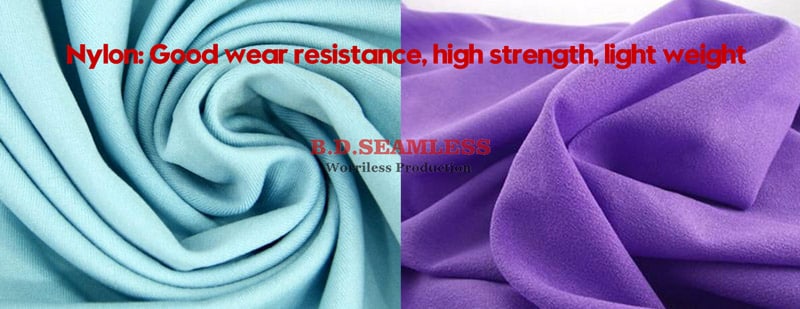Polyamide represents polyamide fiber and is also called as nylon. It is categorized into the synthetic fiber with the polyester. The nylon 6 and nylon 66 fiber is commonly used in the production of underwear and currently nylon 6 fiber takes a leading position in China.
Polyamide is the first synthetic fiber produced in the world. It is featured by high strength, wear resistance and sound resilience. Its moisture absorption and thermal setting characteristics enable resistance of bend deformation during heating. It is widely using by many custom fitness clothing manufacturers.
The advantages and disadvantages of nylon fabric for production of seamless clothing are summarized as follows:
Advantages
1, Good wear resistance: Its wear resistance tops that of other fabrics, nylon is 10 times more wear-resistant than cotton and 20 times more wear-resistant than wool. The addition of some poly amide fibers into the blend fabric will improve significantly its wear resistance; when it is elongated by 3% to 6%, the elastic recovery rate can reach 100%; it can withstand tens of thousands of bending and winding without any rupture.
2, High strength: Nylon is 1 to 2 times tougher than cotton, 4 to 5 times tougher than wool and 3 times tougher than viscose fiber.
3, Light weight: The low density and light weight of the nylon fabric is second only to that of the polypropylene and acrylic fabric, it is lighter than cotton and viscose fiber; so, it is suitable for making mountaineering and winter wear.
4, Good dyeability: The dyeability of nylon is better than that of polyester.
5, Good alkali-resistant and anti-reductant, anti-mildew and insect-resistant properties.
6, Low temperature resistance: The nylon filament is featured by its good low temperature resistance and no great changes of resilience even under -70℃.

Disadvantages:
1, Poor heat resistance: If being placed under 150℃, the nylon fabric will turn yellow after 5 hours with significantly decreased strength, elongation and increased shrinkage. The instructions for washing and maintenance must be noted in its use to avoid damages to the fabric.
2, Poor light resistance: The greatest disadvantage of the nylon fabric is its poor resistance to sunlight, the fabric will turn yellow after long exposure to sunlight and its strength declines, so it is not suitable for making outdoor clothing.
3, Poor moisture absorption: The moisture absorption and comfort of the nylon fabric is poor, but is better than that of acrylic and polyester fabric.
4, Poor acid resistance and anti-oxidant properties;
5, Static electricity: Its low DC conductivity will easily cause static electricity by friction during its processing and the nylon clothing is susceptible to fuzzing and pilling after being worn for a long time.
6, Deformability: The small initial modulus of nylon will result in deformation under external force, so the nylon fabric is susceptible to crease in its use and is not crisp.


